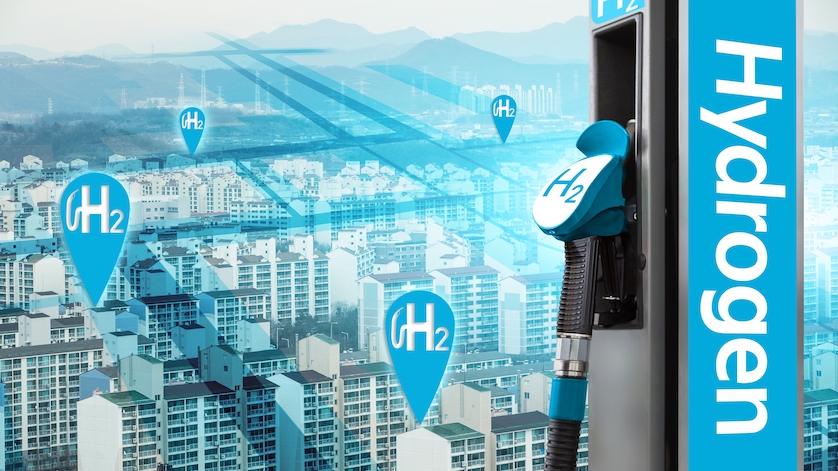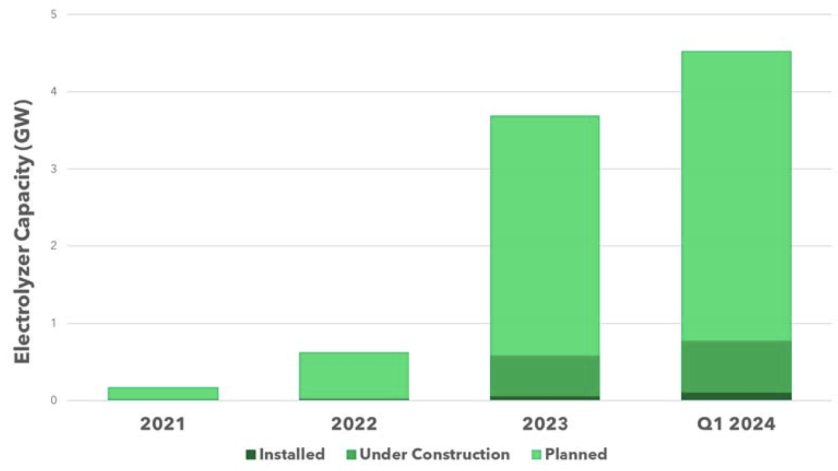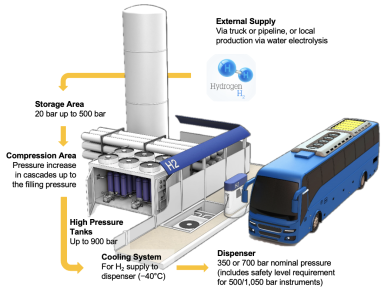
While a mature hydrogen infrastructure is still decades to come, the U.S. is making progress toward that zero-carbon future with more electrolyzer installations and advancements in hydrogen transport, storage, and dispensing. Hydrogen-compatible measuring instruments play an important role in such projects.
The word moonshot entered the popular lexicon during the Cold War as a way to describe an especially ambitious project with a tremendous payoff. The United States accomplished that mission in July 1969 with Apollo 11 landing on the moon and returning safely. Decades later, the government has turned the lens back on our planet with equally ambitious goals of solving the climate crisis through clean fuels.
The U.S. Department of Energy (DOE) launched Energy Earthshots in 2021 to drive breakthroughs in – and the adoption of – affordable and reliable clean energy solutions. Of the eight “shots,” one focuses on the promise of hydrogen. The Hydrogen Shot aims to “accelerate innovation and spur demand of clean hydrogen by reducing the cost by 80%, to $1 per 1 kilogram of clean hydrogen within 1 decade.” In October 2024, the DOE’s Hydrogen Program announced up to $46 million to advance hydrogen and fuel cell technologies to support innovations in commercial-scale hydrogen installations.
Barriers to Hydrogen Mobility
One day, there will be more electric vehicles (EVs) – both passenger and commercial – on the roads than ones powered by an internal combustion engine. Vehicles that use hydrogen fuel cells hold key advantages over plug-in EVs in that they are refueled very similarly to gasoline- and diesel-powered vehicles: pump and go. The issue, of course, is the lack of a widespread hydrogen infrastructure.
Advances in hydrogen mobility will hinge on our ability to expand the network of refueling stations so that no detours are necessary to refill a hydrogen tank. Of the roughly 700 hydrogen fueling stations worldwide, the U.S. currently has 58 of them – almost all in California (Alternative Fuels Data Center, DOE).
Hydrogen production
Parallel to increasing the number of hydrogen fueling stations is the need to move away from using hydrocarbons as the feedstock. Most of the H2 used today is derived from natural gas in a process called steam methane reforming (SMR); this is gray hydrogen, and one of its byproducts is carbon dioxide. If the carbon is captured and stored as part of the process, that’s blue hydrogen.
Achieving net zero calls for moving toward electrolysis: splitting water molecules with electricity, preferably from renewable sources like solar and wind. This is green hydrogen. As of May 2024, existing and planned electrolyzer installations in the U.S. totaled about 4.5 GW, a ~20% increase since 2023 (DOE Hydrogen Program).

Existing and planned electrolyzer installations (cumulative) in the U.S. as of May 2024 (source: DOE)
Supply challenges and high prices are the main reasons that some hydrogen stations in the U.S. have closed in late 2023 and early 2024. For hydrogen mobility to become a reality, the DOE’s Hydrogen Shot needs to reach its goal.
Hydrogen delivery and storage
Once the hydrogen is produced, whether by SMR or electrolysis, it needs to be delivered to a fueling station. Currently, H2 is transported in “tube trailers” – semitrailers with a cluster of steel tube tanks. In the future, these tanks will be replaced by Type IV carbon fiber tanks, which are able to withstand higher tank pressure (greater compression means more product can be transported) while being much lighter.
Further down the line, it would make economic sense for a large chain of hydrogen fueling stations to produce its own hydrogen using green electricity and to lay pipelines to connect electrolyzers with its network of stations.
Unique Challenges of Working with Hydrogen
Due to this element’s physical and chemical properties, standard measuring instruments are unsuitable for hydrogen applications.
- H2 is highly flammable, so electronic instrumentation like pressure sensors need to have explosion-proof or intrinsically safe designs that meet the requirements for hydrogen gas.
- H is the smallest atom, and H2 is the smallest molecule. Using instrumentation with unsuitable materials can lead to hydrogen permeation and embrittlement, which not only means impaired sensors, but emissions can lead to explosions in concentrations as low as 4% of air.
- As the lightest gas, H2 has to undergo significant compression before it can be efficiently transported and stored, which is currently expensive due to the necessary energy expenditure.
For instruments to be suitable for use in hydrogen fueling stations, they should have these qualities:
- Threaded connections that use metal seals (no elastomers) or directly welding the instrument connection to the process.
- Wetted parts or sensor elements made from 316L (316 stainless steel with a low carbon content), 316Ti (titanium-stabilized version of 316), 2.4711 Elgiloy® (a cobalt-chromium-nickel-molybdenum alloy), Hastelloy® C276 (a nickel-molybdenum-chromium-tungsten alloy), or other austenitic steels.
- Ability to withstand pressures up to 900 bar (13,050 psi).
- Ability to operate reliably within a −40°C to 85°C (−40°F to 185°F) temperature range.
Putting the Squeeze on Hydrogen: Pressure, Temperature, and Time
Currently, H2 is transported in tube trailers at a pressure of 200 bar (2,900 psi). At the hydrogen fueling station, the gas is further compressed in several stages, up to 900 bar in high-pressure tanks using hydrogen compressors. For dispensing, hydrogen is decompressed to 700 bar (10,150 psi) for passenger cars and to 350 bar (5,075 psi) for trucks. (In the near future, the tank pressure of trucks will increase to 700 bar to achieve a longer driving range.) The dispenser’s sensor system communicates with the vehicle’s H2 tank to control the gas’s pressure and flow rate.

Depending on the system, there are up to 20 hazardous-area pressure transmitters (0…25 to 0…1,050 bar) installed in a hydrogen filling station. (click to enlarge)
The hydrogen fueling process needs to be completed in the shortest possible time. Pressure and temperature measurement plays an important role in this process: the larger the pressure difference between the fueling station and the vehicle, the faster the hydrogen will flow. Understandably, the vehicle tank pressure must not be exceeded. The temperature gradient over the fueling line means that time is a factor too: hydrogen heats up when it expands (Joule-Thomson effect). The gas is accordingly cooled down beforehand to −40°F using a heat exchanger, so that a temperature below 185°F can safely be maintained. This is necessary because vehicle tanks are designed for this temperature only. The closer the temperature gets to 185°F, the more the fueling process must be slowed down and regulated by cooling.
Reliable Instrumentation for Demanding Hydrogen Systems
A hydrogen station has complex systems that rely on robust specialized measuring instruments for safe and efficient operations.
- Temperature sensors need to have short response times, which is why thermowells are not recommended. The unprotected probe tip must be able to withstand pressures up to 900 bar (13,000 psi) and have a compact design in order to minimize its impact on the hydrogen’s flow. A conical threaded connection will give the temperature indicator the necessary strength while keeping the measuring point reliably sealed.
- Pressure sensors on the dispenser should have a nominal pressure of 1,000 bar (14,500 psi); this value is based on the vehicle’s nominal tank pressure (a maximum of 700 bar) plus a temperature-related safety buffer. In addition, pressure instruments must be rated for operating in the temperature range for hydrogen fueling stations, typically −40°F to 185°F, and be approved for use in hazardous areas.
- Flow sensors monitor the flow rate of the compressed or liquefied hydrogen. Coriolis flow meters are particularly suited to this task, as they are able to withstand the high pressures involved in hydrogen applications.
The E-10 explosion-proof and flameproof pressure transmitter is designed for the most demanding applications, including hydrogen. It has a measuring range of up to 1,000 bar (14,500 psi ) and has several approvals for use in hazardous areas (FM, CSA, ATEX, IECEx). The IS-3 intrinsically safe pressure transmitter is another excellent option for hydrogen service.
The TC90 high-pressure thermocouple provides fast response times without the need of a thermowell. It is built with metal-to-metal sealing and high-pressure threaded connectors that hold up reliably in demanding hydrogen applications.
These are just some of the many hydrogen measurement solutions that WIKA offers. See this article for more products.
WIKA USA: Your Source for Smart Hydrogen-Compatible Sensors
The U.S. is just starting out on its journey toward a hydrogen economy, which is seeing much faster adoption around the globe, notably in China but also South Korea and Japan. In Europe, Germany has the most extensive network of hydrogen fueling stations. Whether your company is a hydrogen pioneer or just starting to explore adding hydrogen mobility to your portfolio, contact the product specialists at WIKA USA for expert advice and personalized recommendations.
Products mentioned in this article
• E-10 explosion-proof and flameproof pressure transmitter
• IS-3 intrinsically safe pressure transmitter
• TC90 high-pressure thermocouple

